Seismic time-history analysis of block-faced reinforced-soil retaining wall based on pseudo-dynamic method
Abstract
The horizontal displacement of a reinforced-soil retaining wall is a common deformation mode of seismic damage. The horizontal displacement time history and accumulative deformation after earthquakes are important parameters for evaluating the seismic performance of a reinforced-soil retaining wall, but theoretical study on this issue is scarce at the moment. In this study, an analytical method is proposed to calculate the horizontal displacement time history of a block-faced reinforced soil retaining wall. The method is based on the pseudo-dynamic method and differential kinematics equations, and this method was used to calculate the reinforcement material's tensile displacement and overall displacement in the reinforced area under earthquake motion, while simultaneously taking into account the accumulative deformation. The rationality and accuracy of this method are verified through comparison with model experiments and existing theories. Besides, parameter analysis was carried out to further confirm the applicability of this method. The study shows the method takes into account the influence of the accumulated deformation, and can effectively calculate the horizontal displacement time history of the block-faced reinforced soil retaining wall under larger magnitudes. Although the calculated values are smaller than the actual deformation, they are still relatively close.

 求助内容:
求助内容: 应助结果提醒方式:
应助结果提醒方式:


